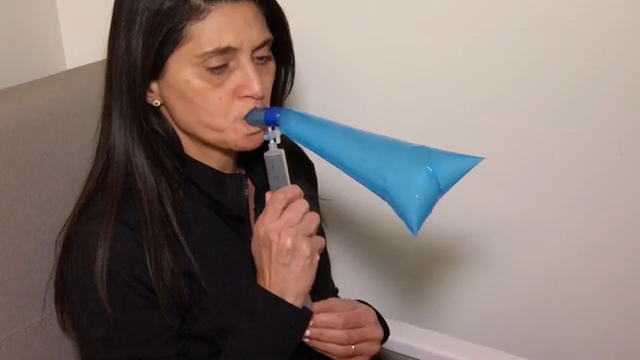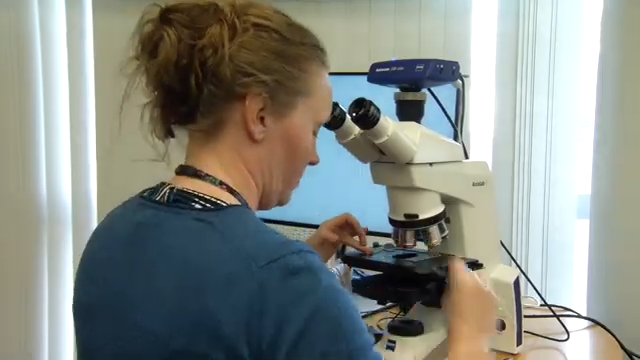SAN DIEGO, Calif. (Ivanhoe Newsire) – Heart disease is the leading cause of death for everyone in the United States. Did you know, one in five heart attacks is silent? That means the damage is done, but the person is not even aware they had one. That’s why being able to predict changes in your heart, organs, and arteries is vital to preventing the worst from happening. Now, the first-ever wearable patch may be able to predict cardiovascular problems earlier than ever before.
Every 40 seconds, someone in the United States has a heart attack. Every three and half minutes, someone will die of a stroke. Research shows that 80% of all heart disease can be prevented by knowing and managing risk factors. That’s why the team inside a UCSD lab is working on something new.
UCSD nanoengineer, Boyu Liu says, “We are working on soft stretchable sensors.”
“This is the ultrasonic patch we are developing,” says UCSD material sciences student, Sai Thou.
Nanoengineer at the UCSD Jacobs School of Engineering, Sheng Xu, PhD explains, “This device can provide continuous long-term monitoring of what’s going on in the heart.”
This group of engineers is the first to develop a flexible, wearable, ultrasound patch.
“With ultrasound, we can penetrate the tissue and get very deep targets,” Liu says.
“For example, I can easily attach it to my clothing artery like this,” Thou demonstrates.
Embedded in a sheet of flexible polymer is an array of millimeter-sized ultrasound transducers. When worn on the neck or chest, it can penetrate the tissue, monitor blood flow, blood pressure, and heart function, in hopes of predicting heart attacks or strokes.
Xu adds, “We can use sophisticated algorithms to predict what’s going to happen in the next minute, in the next hour, or in the next few days.”
Knowing how fast the blood flows through the vessels can help diagnose blood clots, heart valve problems, poor circulation and blockages in the arteries, and help doctors save your life.
In tests, the patch performed as well as commercial ultrasound probes, which are currently used in doctor’s offices. Although they still have more testing to do, the researchers at UCSD are hopeful that this could be made available to doctors and their patients in the next two years.
Contributors to this news report include: Marsha Lewis, Producer; Roque Correa, Videographer & Editor.
To receive a free weekly e-mail on medical breakthroughs from Ivanhoe, sign up at: http://www.ivanhoe.com/ftk
Sources:
https://www.cdc.gov/heartdisease/facts.htm
https://professional.heart.org/en/science-news/heart-disease-and-stroke-statistics-2022-update
MEDICAL BREAKTHROUGHS
RESEARCH SUMMARY
TOPIC: SKIN PATCH PREDICTS HEART ATTACKS AND STROKES: MEDICINE’S NEXT BIG THING?
REPORT: MB #5148
BACKGROUND: A stroke, sometimes called a brain attack, occurs when something blocks blood supply to part of the brain or when a blood vessel in the brain bursts. In either case, parts of the brain become damaged or die. A stroke can cause lasting brain damage, long-term disability, or even death. In the United States, about 795,000 people suffer a stroke each year. Someone has a stroke every 40 seconds, and every 4 minutes, someone dies from stroke. There are more than 140,000 deaths each year from stroke. Statistics show that about 40% of stroke deaths occur in males and 60% in females.
https://www.strokeinfo.org/stroke-facts-statistics/)
DIAGNOSING: To diagnose a stroke, doctors will perform different tests that include a physical exam, blood tests, a CT scan, an MRI, a carotid ultrasound, cerebral angiogram, and an echocardiogram. Signs and symptoms of stroke include trouble speaking and understanding what others are saying, paralysis or numbness of the face, arm or leg, problems seeing in one or both eyes, headache, and/or trouble walking.
(Sources: https://www.mayoclinic.org/diseases-conditions/stroke/diagnosis-treatment/drc-20350119
https://www.mayoclinic.org/diseases-conditions/stroke/symptoms-causes/syc-20350113)
NEW TECHNOLOGY: Engineers at the University of California San Diego developed a soft and stretchy ultrasound patch that can be worn on the skin to monitor blood flow through major arteries and veins deep inside a person’s body. Knowing how fast and how much blood flows through a patient’s blood vessels is important because it can help clinicians diagnose various cardiovascular conditions, including blood clots; heart valve problems; poor circulation in the limbs; or blockages in the arteries that could lead to strokes or heart attacks. The new ultrasound patch developed at UC San Diego can continuously monitor blood flow — as well as blood pressure and heart function — in real time. Wearing such a device could make it easier to identify cardiovascular problems early on.
FOR MORE INFORMATION ON THIS REPORT, PLEASE CONTACT:
Liezel Labios
If this story or any other Ivanhoe story has impacted your life or prompted you or someone you know to seek or change treatments, please let us know by contacting Marjorie Bekaert Thomas at mthomas@ivanhoe.com




